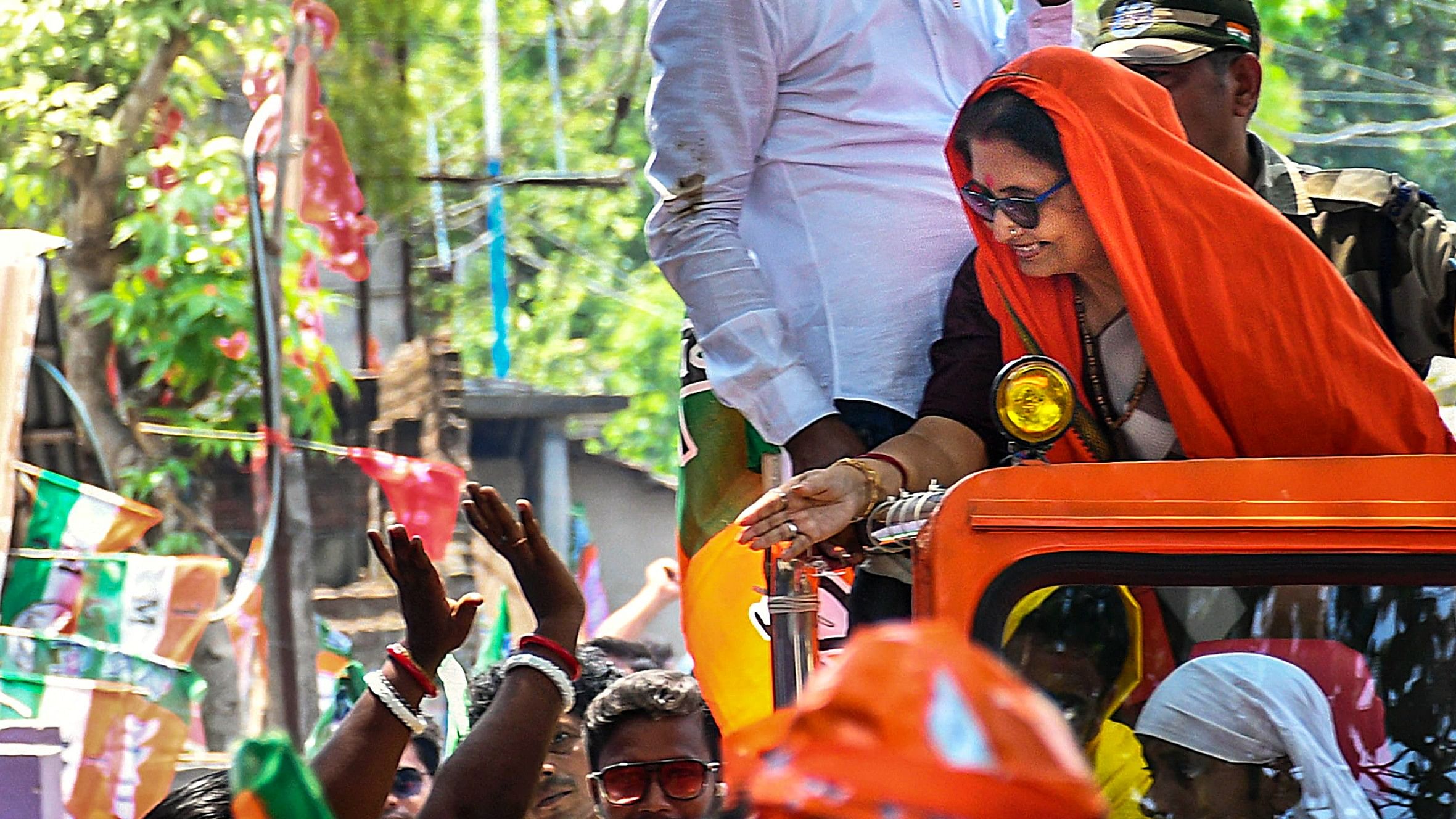
JP candidate from Krishnanagar constituency Amrita Roy during her election campaign for Lok Sabha elections, at Krishnanagar in Nadia district.
Credit: PTI photo
Krishnanagar (West Bengal): “Had the regime of Siraj ud Daulah not dislodged then, it would have been difficult to save Sanatana Dharma,” Amrita Roy says as she defends her husband’s ancestor Raja Krishna Chandra Roy, whom the history accuses of betraying the last independent Nawab of Bengal and of joining Mir Zafar, Jagat Seth, and Omi Chand in colluding with Robert Clive to ensure the East India Company’s victory in the ‘Battle of Plassey’ on June 23, 1757. “We would have perhaps had to convert to another religion,” adds Roy, whom the Bharatiya Janata Party fielded to take on Mahua Moitra of Trinamool Congress in the Krishnanagar Lok Sabha constituency in West Bengal.
After two back-to-back rallies in the morning and before a ‘roadshow’ in the evening, Roy – ‘Rani Ma’ for many in Krishnanagar – takes a brief break and sits with her campaign coordinators amid a clutter of antique furniture in one of the rooms of the ‘Raj Bari’. The royal palace was built during the reign of Krishna Chandra Roy, also immortalised in Bengal’s folklore as the ‘Raja’ who was often outwitted by his court jester, Gopal Bhar, just as Mughal Emperor Akbar was by Birbal.
The BJP is leaving no stone unturned to ensure the victory of ‘Rani Ma’, and, of course, the defeat of Moitra, who won from Krishnanagar in 2019 with a margin of over 63000 votes, hit the headlines repeatedly for her fiery tirade against Prime Minister Narendra Modi’s government in the Lok Sabha and was finally expelled from the House in December 2023 for sharing her log-in ID and password for the parliament portal. Modi, Home Minister Amit Shah, and the other top BJP leaders addressed rallies in Krishnanagar to pre-empt the firebrand investment-banker-turned-politician’s return to the Lok Sabha.
Roy promises to work on improving rural road connectivity and rail infrastructure, rejuvenating the rivers, breathing new life into the jute industry, and reviving the Plassey Sugar Mill, apart from ensuring that the funds provided by the Union Government are properly utilized for the people of Krishnanagar.
The BJP’s campaign against the TMC candidate is focused on her expulsion from the Lok Sabha. “She has hardly spoken for the development of Krishnanagar in the Lok Sabha in the past five years. She never tried to connect with the common people of her constituency,” Pradip Ghosh, the general secretary of the BJP’s Nadia district unit, says. “Her life choices are now well known to the people, thanks to social media”, adds Ghosh. He also believes that the CPI(M)’s S M Sadi will get a significant number of votes from the Muslims, who constitute 40% of the constituency’s electorate and who voted en masse for the TMC in the earlier elections, making Krishnanagar a stronghold for the TMC since 2009. “The split in the minority vote bank will help us ensure Rani Ma’s victory”.
Roy studied at Kolkata’s prestigious academic institutions like La Martiniere School, Rani Birla College, Loreto House, and Pratt Memorial School. She took fashion design as her profession. She spent years abroad as her husband, Soumish Chandra Roy, whom she married in 1981, worked with Air India.
She divides her time between the ‘Raj Bari’ in Krishnanagar and her family’s second home in Kolkata.
‘Rani Ma’ says she has been interacting with people, particularly at the ‘Nat Mandir’ of the palace during the Raj Rajeshwari Jagatdhatri Puja – an annual religious ceremony started by Raja Krishna Chandra Roy. “The BJP had offered me the party’s nomination even earlier. But I decided to take the plunge this time, as I thought I should do my bit to save West Bengal, where corruption has become commonplace,” she says, subtly taking a dig at the TMC.
The saffron party is keen to cash in on the respect the royal family still commands in Krishnanagar. But the party’s leaders fear that Rani Ma’s outbursts against Siraj ud Daulah in response to the TMC’s reference to Raja Krishnachandra Roy’s ‘betrayal’ may backfire. “Neither Siraj ud Daulah nor Krishna Chandra Roy nor Robert Clive are contesting the elections. We don’t want to talk about them,” says local BJP leader Kalyan Nandi.
Rani Ma is unrelenting though. “There was widespread resentment against Siraj ud Daulah, who was an outsider and who used to force young women to take plunges in the river so that he could enjoy the sight,” she says, continuing to justify the ‘betrayal’ that laid the foundation of the two-century-long rule of British Raj over India. She also talks about her husband’s grandmother Jyotirmoyee Devi, who played a key role in bringing back Nadia and Krishnanagar to India after it was initially decided that the region would go to East Pakistan after the Partition of India in August 1947.
Moitra, on the other hand, is relying on the welfare schemes and development projects launched by Chief Minister Mamata Banerjee’s government in the state. To blunt the BJP’s allegation of elitism and disconnect with the voters of the constituency, she launched her campaign with a series of “Mukhomukhi Mahua (Face-to-Face with Mahua)” events where she interacted with the people, heard and took note of their grievances and demands. She claims credit for several development initiatives, including upgrading hospitals and expanding road and rail connectivity
